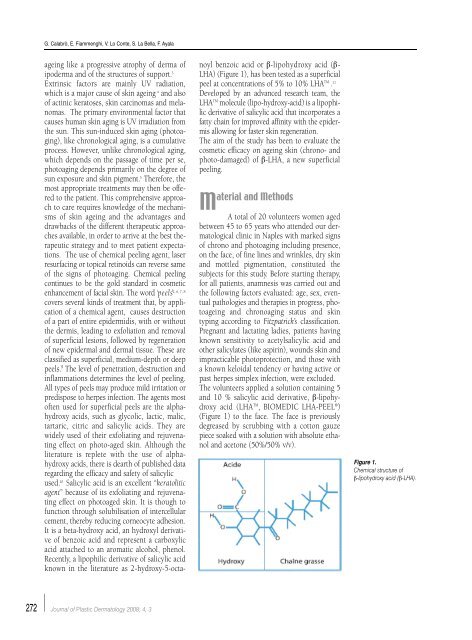N° 3 - Salute per tutti
N° 3 - Salute per tutti
N° 3 - Salute per tutti
You also want an ePaper? Increase the reach of your titles
YUMPU automatically turns print PDFs into web optimized ePapers that Google loves.
272<br />
G. Calabrò, E. Fiammenghi, V. Lo Conte, S. La Bella, F. Ayala<br />
ageing like a progressive atrophy of derma of<br />
ipoderma and of the structures of support. 3<br />
Extrinsic factors are mainly UV radiation,<br />
which is a major cause of skin ageing 4 and also<br />
of actinic keratoses, skin carcinomas and melanomas.<br />
The primary environmental factor that<br />
causes human skin aging is UV irradiation from<br />
the sun. This sun-induced skin aging (photoaging),<br />
like chronological aging, is a cumulative<br />
process. However, unlike chronological aging,<br />
which depends on the passage of time <strong>per</strong> se,<br />
photoaging depends primarily on the degree of<br />
sun exposure and skin pigment. 5 Therefore, the<br />
most appropriate treatments may then be offered<br />
to the patient. This comprehensive approach<br />
to care requires knowledge of the mechanisms<br />
of skin ageing and the advantages and<br />
drawbacks of the different therapeutic approaches<br />
available, in order to arrive at the best therapeutic<br />
strategy and to meet patient expectations.<br />
The use of chemical peeling agent, laser<br />
resurfacing or topical retinoids can reverse same<br />
of the signs of photoaging. Chemical peeling<br />
continues to be the gold standard in cosmetic<br />
2, 6, 7, 8<br />
enhancement of facial skin. The word ‘p e e l s’<br />
covers several kinds of treatment that, by application<br />
of a chemical agent, causes destruction<br />
of a part of entire epidermidis, with or without<br />
the dermis, leading to exfoliation and removal<br />
of su<strong>per</strong>ficial lesions, followed by regeneration<br />
of new epidermal and dermal tissue. These are<br />
classified as su<strong>per</strong>ficial, medium-depth or deep<br />
peels. 9 The level of penetration, destruction and<br />
inflammations determines the level of peeling.<br />
All types of peels may produce mild irritation or<br />
predispose to herpes infection. The agents most<br />
often used for su<strong>per</strong>ficial peels are the alphahydroxy<br />
acids, such as glycolic, lactic, malic,<br />
tartaric, citric and salicylic acids. They are<br />
widely used of their exfoliating and rejuvenating<br />
effect on photo-aged skin. Although the<br />
literature is replete with the use of alphahydroxy<br />
acids, there is dearth of published data<br />
regarding the efficacy and safety of salicylic<br />
used. 10 Salicylic acid is an excellent “keratolitic<br />
agent” because of its exfoliating and rejuvenating<br />
effect on photoaged skin. It is though to<br />
function through solubilisation of intercellular<br />
cement, thereby reducing corneocyte adhesion.<br />
It is a beta-hydroxy acid, an hydroxyl derivative<br />
of benzoic acid and represent a carboxylic<br />
acid attached to an aromatic alcohol, phenol.<br />
Recently, a lipophilic derivative of salicylic acid<br />
known in the literature as 2-hydroxy-5-octa-<br />
Journal of Plastic Dermatology 2008; 4, 3<br />
noyl benzoic acid or !-lipohydroxy acid (!-<br />
LHA) (Figure 1), has been tested as a su<strong>per</strong>ficial<br />
peel at concentrations of 5% to 10% LHA TM . 11<br />
Developed by an advanced re s e a rch team, the<br />
L H A T M molecule (lipo-hydroxy-acid) is a lipophilic<br />
derivative of salicylic acid that incorporates a<br />
fatty chain for improved affinity with the epidermis<br />
allowing for faster skin re g e n e r a t i o n .<br />
The aim of the study has been to evaluate the<br />
cosmetic efficacy on ageing skin (chrono- and<br />
photo-damaged) of !-LHA, a new su<strong>per</strong>ficial<br />
peeling.<br />
aterial and Methods<br />
M<br />
A total of 20 volunteers women aged<br />
between 45 to 65 years who attended our dermatological<br />
clinic in Naples with marked signs<br />
of chrono and photoaging including presence,<br />
on the face, of fine lines and wrinkles, dry skin<br />
and mottled pigmentation, constituted the<br />
subjects for this study. Before starting therapy,<br />
for all patients, anamnesis was carried out and<br />
the following factors evaluated: age, sex, eventual<br />
pathologies and therapies in progress, photoageing<br />
and chronoaging status and skin<br />
typing according to Fitzpatrick’s classification.<br />
Pregnant and lactating ladies, patients having<br />
known sensitivity to acetylsalicylic acid and<br />
other salicylates (like aspirin), wounds skin and<br />
impracticable photoprotection, and those with<br />
a known keloidal tendency or having active or<br />
past herpes simplex infection, were excluded.<br />
The volunteers applied a solution containing 5<br />
and 10 % salicylic acid derivative, !-lipohydroxy<br />
acid (LHATM , BIOMEDIC LHA-PEEL ® )<br />
(Figure 1) to the face. The face is previously<br />
degreased by scrubbing with a cotton gauze<br />
piece soaked with a solution with absolute ethanol<br />
and acetone (50%/50% v/v).<br />
Figure 1.<br />
Chemical structure of<br />
!-lipohydroxy acid (!-LHA).

















